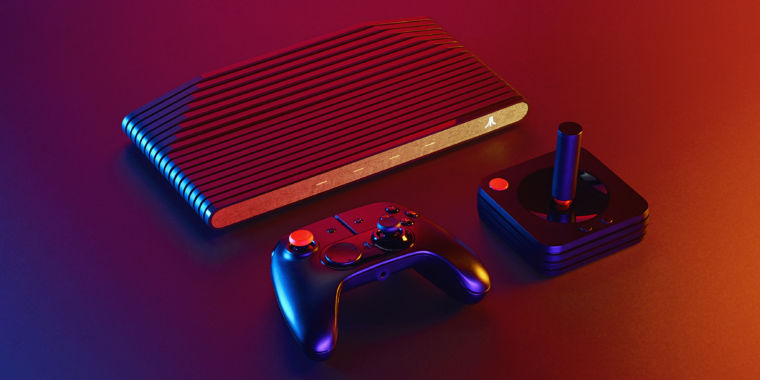Atari doesn’t want you to call its new VCS a “console”

-
The $250 base system (with 4GB of RAM) doesn’t include either of these two controllers.
-
The “one button” joystick has an extra button on the shoulder.
-
Note the red highlights that call back to the old Atari one-button joystick.
-
The version with black walnut paneling on the front is exclusive to AtariVCS.com.
-
This black and red design is a GameStop exclusive.
-
The “Kevlar Gold” design can only be found at Walmart.
LOS ANGELES—At E3 meetings this week, Atari finally showed off playable, near-final prototypes of its long-delayed, heavily crowdfunded VCS, the company’s modernized homage to the original Atari Video Computer System (aka the 2600). Obviously, there was a lot of discussion of what the system—which starts at $250 in a package without controllers—actually is at this point. But there was just as much focus on what it is not.
First off, representatives wanted to stress that despite outward appearances, this is not just a retro “mini” console along the lines of the NES Classic Edition or the recently announced TurboGrafx-16 Mini (or even the long-running Atari Flashback line). Yes, the VCS will come with a collection of classic games in the “Atari Vault,” and Atari will also sell classic 2600 ROMs that work through a built-in emulator. And yes, players can buy a $50 wireless, rumbling, four-direction, “single-button” digital joystick modeled after Atari’s classic design. That joystick comes complete with modern touches like menu buttons, an LED light ring that responds to directional input, and a stick that rotates on its axis for “paddle” controls.
But Atari representatives stressed that the VCS is a modern platform, powered by a Ryzen R1606G Raven 2 APU (roughly the equivalent of a Zen 2 4-core CPU and a Vega GPU). That can handle 4K video streams, which means it’s ready for services like Google Stadia or Microsoft’s Xcloud. Getting 4K resolution on a locally run game with a decent level of 3D detail and acceptable frame rate seems nearly impossible, though. Atari’s provided example of a “modern” game running on the system was a Linux version of Borderlands 2, a 2012 title that frankly chugged along at a pretty choppy frame rate in our hotel-suite demonstration.
Atari also doesn’t like it when people call the VCS a “console.” That word implies a closed system, often sold at a loss, where the platform-holder has full control over the hardware and the apps and games that can be sold and run on it. On this score, the VCS does at first look a lot like a console, with a slick interface allowing users to buy and play downloaded titles (what titles will be available, beyond Atari classics, will not be known until announcements later this summer).
A console for tinkerers?
What Atari says differentiates the VCS from the current console competition (aside from selling the hardware at a profit) is its friendliness to tinkering and homebrewing. While hackers won’t be able to replace the system’s central APU chip, the internal SSD and RAM can be easily accessed and replaced with standard parts, providing at least a modicum of “future-proofing,” representatives said.
More than that, the built-in “sandbox mode” will let VCS users load up any bootable operating system contained on an external hard drive. That means you can boot into a full copy of Windows and run your Steam games through the VCS if you want. The relative failure of Steam’s own TV-based console initiative suggests this may be a niche use case, but it’s there if you want it.
-
The Atari VCS controller looks a lot like an Xbox pad. The system will work with generic USB and bluetooth controllers, too.
-
The stick on the joystick controller twists to support paddle-controlled games.
-
Early prototypes of the casing and controllers.
-
Rear ports.
-
An engineering prototype of the Atari VCS, used to test for sizing and heat dissipation.
Sandbox mode will also let VCS users access the system’s Linux 5.0 kernel directly and, with a mouse and keyboard plugged in to two front USB ports, even develop their own games to submit to Atari’s platform. Any game designed to run on Ubuntu should be playable on the VCS, representatives said, though developers may have to make slight changes to work with the VCS’ full-screen display buffer.
There weren’t many details on the app and game submission process, but Atari suggested it would be akin to Apple’s iOS App Store. That means apps will have to go through a quick approval process before being sold, somewhere between the nearly-anything-goes Android store and the curated, requirement-heavy approach of a console platform.
“I want it to be a box where you can develop an app for the living room,” Atari Systems Architect Rob Wyatt told Ars. “We want to be the Raspberry Pi of the living room.”
When I pointed out that this sounded very similar to the pitch for Ouya’s failed microconsole model, Wyatt said that “Ouya’s problem was they went down the Android path, and with it they brought a lot of crap. This is far more curated than that, and it’s exactly why we don’t want the Android store model… It’s not just ‘Android in your living room’ [as Ouya was].”
There’s one final thing Atari insisted that the VCS is not: vaporware. Though we’re now well past the initially promised “spring 2018” release, GameStop and Walmart are now taking preorders for a system that they expect to be on store shelves next March (IndieGogo backers should receive units in December). Whatever happens after that, Atari’s road back to making TV-based gaming hardware has certainly been a long and interesting one.
https://arstechnica.com/?p=1521831